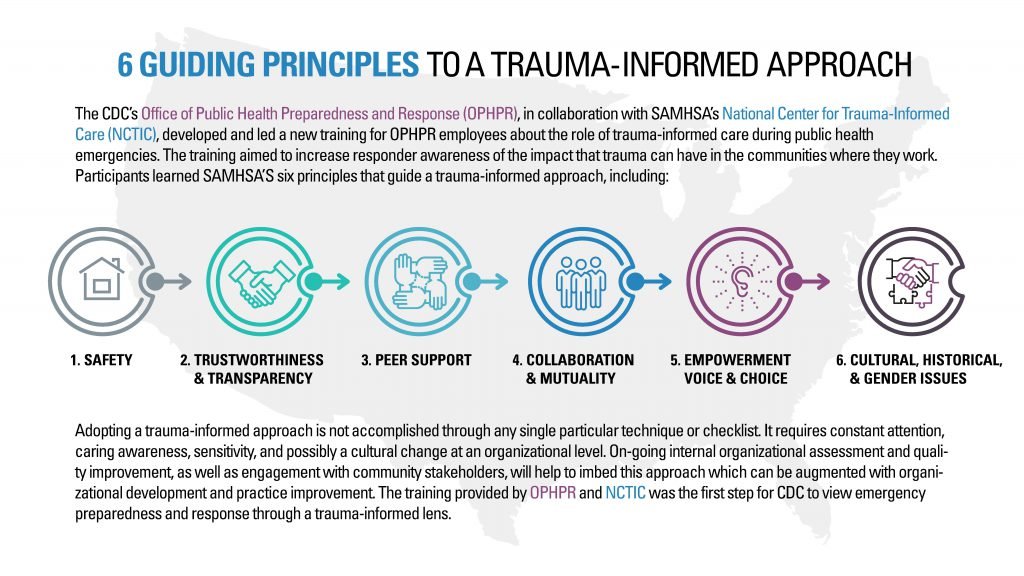
Trauma-informed care is a hot topic across every school district.
Providing Trauma-informed Care: 5 Tips for Teachers
Recently, Concordia University’s School of Education gathered for some interdepartmental education and inspiration. The Graduate Counseling Department led a seminar on trauma-informed care for their peers, encouraging them to share the information with their education students, many of whom will be graduating this spring. Professors Audrey DiMaggio Fiore and Mary Buenz laid out five tips for providing the trauma-informed care these soon-to-be-teachers can implement in their classrooms.
The team began by using a variety of timely resources to offer some background on trauma-informed care. This infographic from the Centers for Disease Control explains a universally accepted approach that demonstrates the many layers of support required to create a proactively trauma-sensitive environment:

They followed with some advice to teachers who are interested in making their classroom the type of setting that will be necessary to address a variety of trauma-related issues. When students are finally able to return after months of home and hybrid instruction, teachers will need to be prepared.
Tip #1: Shift your mindset.
DiMaggio Fiore posed this question to her School of Education peers: How do most teachers view students who misbehave in class? She followed with: “When teaching children who have big feelings, a growth mindset asks: ‘What does this student need?’ and ‘What happened to this student?’ instead of: ‘What is wrong with this child?’”
Growth Mindset
This idea is builds on the concept of the same name that Carol Dweck wrote about in her book, Growth Mindset. Dweck defines it this way: “In a growth mindset, people believe that a person’s most basic abilities can be developed through dedication and hard work—brains and talent are just the starting point. This view creates a love of learning and a resilience that is essential for great accomplishment.” For students who have experienced severe trauma, having a teacher who looks at them as possessing unlimited potential can make a huge difference.
DiMaggio Fiore encouraged teachers to take the growth mindset a step further. This means being aware of your own understanding of behaviors and finding a way to forge a connection with every student, despite disruptions or resistance. She asked, “Are you looking for compliant students, or are you willing to try to understand why they are disruptive?”
Relationships are key in a growth mindset.
Another point DiMaggio Fiore made is to recognize that behavior is typically not about manipulation. “Seek to understand what the student is trying to communicate,” she said. She went on to acknowledge, “There is a lot of pressure on teachers to keep up with their curriculum, but that’s really hard to do when students are struggling with trauma.” Consistently trying to build relationships will ultimately give teachers the tools they need to create a safe learning environment for students. Overall, you can support your students by demonstrating openness, compassion, and empathy that will deepen over time.
Growth-minded teachers also listen to their own needs.
Trauma-informed care emphasizes the needs of caregivers as well, which includes teachers. If you need to take a mental health day or “tag out” from a tense situation, do that. DiMaggio Fiore suggests even starting your day or each lesson with some quick mindfulness exercises and thinking about what your body feels like in the moment. This type of awareness will allow you to gauge your own limits and be ready to step out when needed.
Tip #2: Build compassion
Experts agree: Students must feel physically and emotionally safe before they can begin to focus on lessons. DiMaggio Fiore said it this way for teachers: “Maslow’s Hierarchy before Bloom’s Taxonomy.” In other words, students have to get their most basic needs met before optimal learning can take place.
Teachers can build in ways for the class to create its own community. Having circle time or open sharing every day teaches students to listen to each other. If you treat negative behavior as a skill-deficit or as a way students are trying to communicate, these daily opportunities for practicing acceptance, sincerity and empathy will establish the right environment for all students, especially those who are dealing with trauma.
Tip #3: Meet students where they are
Not every student has the same needs, but every student deserves to have their needs met. Because of this, some students may require more attention or special ways to accommodate their issues. While this can seem unfair to some students, building a level of understanding in the classroom will help everyone get the help they deserve. For example, having all students help develop classroom rules and expectations together allows for buy-in and ownership and helps to create a classroom culture that promotes inclusivity and differentiation. If this is offered from the start, students will come to these conclusions on their own and in a meaningful way.
Tip #4: Empower students
One feeling many victims of violence and abuse experience is a lack of control. Students who act out in school may be attempting to dictate what happens to them, rather than waiting for the next negative event to occur. It can be tempting to want manage every aspect of the classroom, especially for new teachers, but encouraging students to feel empowered pays off in the long run. Self-advocacy and ownership are important feeling to develop in all young people and the classroom is a perfect training ground.
Job charts, class voting and small committees are ways students can feel they have a say in what they are able to do. The CDC refers to this as “empowerment of voice and choice,” and it is an essential aspect of trauma-informed care.
Tip #5: Create Positive Childhood Experiences
While you can’t take away your students’ trauma, you can provide positive childhood experiences as a way to counteract the effects. Your classroom might be the only place where a student feels accepted and encouraged to overcome obstacles. In some cases, a student might not have good friends or a neighbor to help them feel capable and appreciated, but you can create opportunities for this in your classroom.
“When teachers show that they care and take an interest in a student’s life…and learn about why they are struggling,” DiMaggio Fiore said, “that’s comforting for the student.” You as a teacher can provide that feeling of “safe caregiver” by what you believe and how your classroom feels.
Most of all, provide opportunities for fun and enjoyment beyond the curriculum. Building layers of positive experiences with students will create a pathway for replacing the negative experiences students may have accumulated.
Final thoughts on trauma-informed care in the classroom
Trauma-informed care in the classroom can be a difficult and daunting topic. But, with some good strategies for creating a safe and supportive environment, teachers can be central figures in bringing success and joy to learning.
Feeling inspired?
Want to know more about Concordia’s Counseling program? You can book a call with one of our Inquiry Support Specialists. They’re equipped to answer your questions and connect you with the information you need.
—
If this story has inspired you, why not explore how you can help further Concordia's mission through giving.